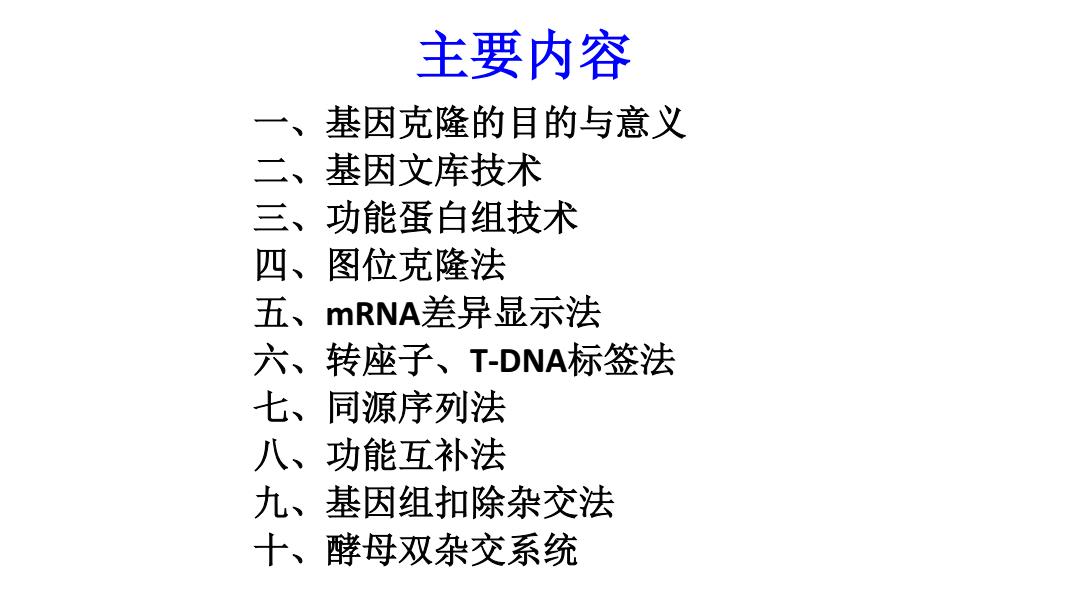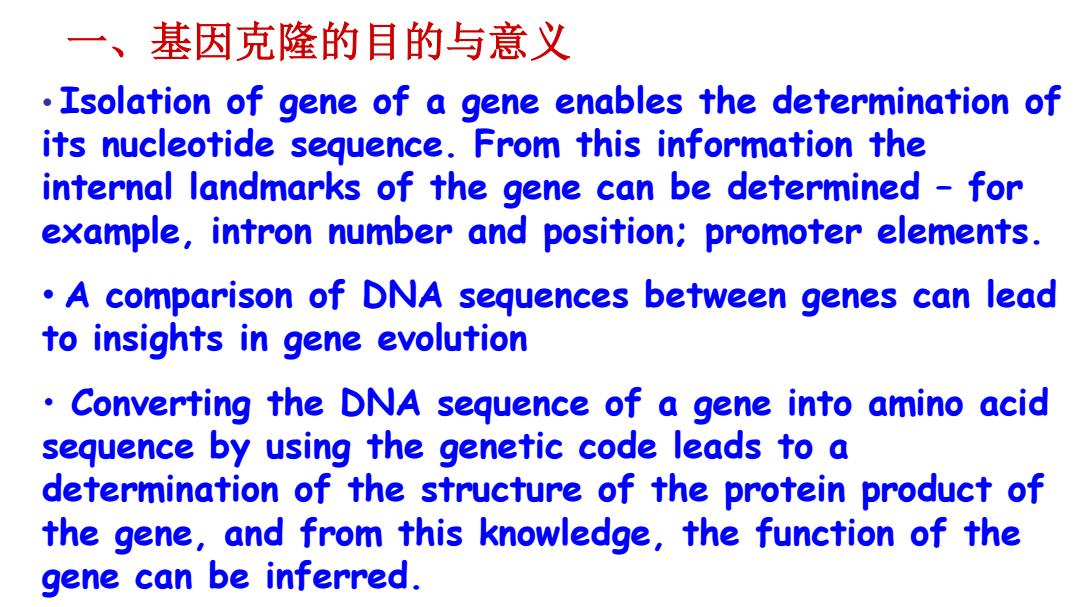
第五章 目的基因的分离
第五章 目的基因的分离

主要内容 二 基因克隆的目的与意义 基因文库技术 三、功能蛋白组技术 四、图位克隆法 五、mRNA差异显示法 六、转座子、T-DNA标签法 七、同源序列法 八、功能互补法 九、基因组扣除杂交法 十、酵母双杂交系统
主要内容 一、基因克隆的目的与意义 二、基因文库技术 三、功能蛋白组技术 四、图位克隆法 五、mRNA差异显示法 六、转座子、T-DNA标签法 七、同源序列法 八、功能互补法 九、基因组扣除杂交法 十、酵母双杂交系统

是否已知基因序列或 氨基酸序列信息 是 否 在本物种或其他物 在本物种或其他物种中 利用转座子T-DNA 利用分子标记 种中已克隆该基因 已知基因编码部分或全 插入创造突变体 定位目标基因 或有同源序列 长氨基酸序列 根据核苷酸或氨基酸序列 设计引物(或简并引物) 突变体库 基因定位图谱 以基因组DNA或CDNA 以扩增出的部分片段为探 转座子或T-DNA 利用BAC或YAC进 为模板PCR扩增 针筛选基因组或cDNA文库 标签法克隆 行图位克隆 目的基因
是 否 在本物种或其他物 种中已克隆该基因 或有同源序列 根据核苷酸或氨基酸序列 设计引物(或简并引物) 以基因组DNA或cDNA 为模板 PCR扩增 在本物种或其他物种中 已知基因编码部分或全 长氨基酸序列 以扩增出的部分片段为探 针筛选基因组或cDNA文库 转座子或T-DNA 标签法克隆 突变体库 基因定位图谱 利用BAC或YAC 进 行图位克隆 利用转座子T-DNA 插入创造突变体 利用分子标记 定位目标基因 是否已知基因序列或 氨基酸序列信息 目的基因

一、基因克隆的目的与意义 Isolation of gene of a gene enables the determination of its nucleotide sequence.From this information the internal landmarks of the gene can be determined for example,intron number and position;promoter elements. A comparison of DNA sequences between genes can lead to insights in gene evolution Converting the DNA sequence of a gene into amino acid sequence by using the genetic code leads to a determination of the structure of the protein product of the gene,and from this knowledge,the function of the gene can be inferred
一、基因克隆的目的与意义 • Isolation of gene of a gene enables the determination of its nucleotide sequence. From this information the internal landmarks of the gene can be determined – for example, intron number and position; promoter elements. • A comparison of DNA sequences between genes can lead to insights in gene evolution • Converting the DNA sequence of a gene into amino acid sequence by using the genetic code leads to a determination of the structure of the protein product of the gene, and from this knowledge, the function of the gene can be inferred

A gene can be moved from one organism to another.An organism containing a "foreign"gene via genetic engineering process is called transgenic. Transgenic organisms can be used either for laboratory research to advance our understanding of biological processes or for specialized industrial applications for examples: *Development of insect resistant crops *Production of human insulin in transgenic bacteria carrying appropriate human gene
• A gene can be moved from one organism to another. An organism containing a "foreign" gene via genetic engineering process is called transgenic. Transgenic organisms can be used either for laboratory research to advance our understanding of biological processes or for specialized industrial applications – for examples: *Development of insect resistant crops *Production of human insulin in transgenic bacteria carrying appropriate human gene